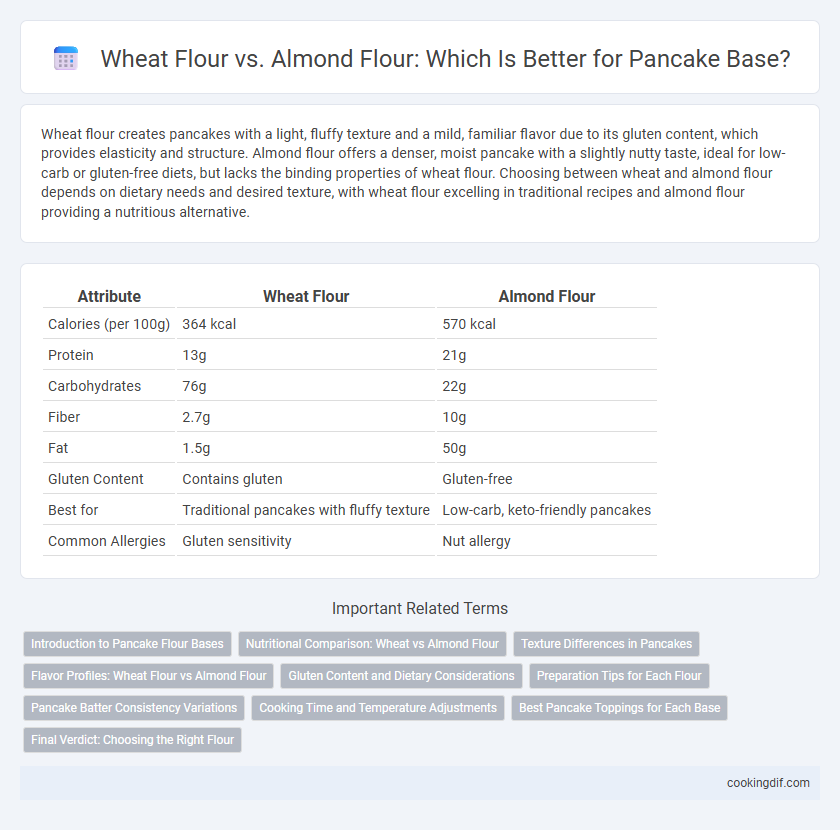Wheat flour creates pancakes with a light, fluffy texture and a mild, familiar flavor due to its gluten content, which provides elasticity and structure. Almond flour offers a denser, moist pancake with a slightly nutty taste, ideal for low-carb or gluten-free diets, but lacks the binding properties of wheat flour. Choosing between wheat and almond flour depends on dietary needs and desired texture, with wheat flour excelling in traditional recipes and almond flour providing a nutritious alternative.
Table of Comparison
| Attribute | Wheat Flour | Almond Flour |
|---|---|---|
| Calories (per 100g) | 364 kcal | 570 kcal |
| Protein | 13g | 21g |
| Carbohydrates | 76g | 22g |
| Fiber | 2.7g | 10g |
| Fat | 1.5g | 50g |
| Gluten Content | Contains gluten | Gluten-free |
| Best for | Traditional pancakes with fluffy texture | Low-carb, keto-friendly pancakes |
| Common Allergies | Gluten sensitivity | Nut allergy |
Introduction to Pancake Flour Bases
Wheat flour is the traditional choice for pancake base, offering a light texture and subtle sweetness due to its gluten content, which aids in structure and fluffiness. Almond flour provides a gluten-free alternative with a denser texture and rich, nutty flavor, ideal for low-carb or paleo diets. Both flours impact the pancake's nutritional profile, with wheat flour higher in carbohydrates and almond flour packing more healthy fats and protein.
Nutritional Comparison: Wheat vs Almond Flour
Wheat flour contains higher carbohydrates and gluten, providing a traditional fluffy texture for pancakes, while almond flour is low in carbs and gluten-free, making it suitable for keto and gluten-sensitive diets. Almond flour offers more protein, healthy fats, and vitamin E, contributing to a nutrient-dense pancake base with a richer flavor. The choice between wheat and almond flour impacts calories, fiber content, and allergen considerations, influencing the pancake's overall nutritional profile.
Texture Differences in Pancakes
Wheat flour produces pancakes with a tender and fluffy texture due to its gluten content, which provides elasticity and structure. Almond flour results in denser, moister pancakes with a slightly grainy texture and a rich, nutty flavor because it lacks gluten. Choosing between these flours affects pancake chewiness and crumb, influencing the overall eating experience.
Flavor Profiles: Wheat Flour vs Almond Flour
Wheat flour provides a mild, slightly nutty flavor with a classic, familiar taste that enhances the texture and structure of pancakes. Almond flour offers a rich, sweet, and distinctly nutty flavor, imparting a moist and dense texture while adding subtle almond undertones. Choosing between wheat and almond flour depends on desired flavor depth and dietary preferences, with almond flour offering a unique, gluten-free alternative.
Gluten Content and Dietary Considerations
Wheat flour contains gluten, providing elasticity and structure to pancakes but can cause issues for those with celiac disease or gluten sensitivity. Almond flour is naturally gluten-free and offers a nutty flavor with higher protein and healthy fats, making it suitable for gluten-free and low-carb diets. Choosing between wheat and almond flour depends on dietary needs, with almond flour catering to gluten-free lifestyles and wheat flour preferred for traditional pancake texture.
Preparation Tips for Each Flour
When preparing pancakes with wheat flour, ensure to sift the flour to avoid lumps and maintain a smooth batter consistency for even cooking. Almond flour pancakes benefit from adding a binding agent like eggs or flaxseed meal to improve structure, as almond flour lacks gluten. Adjust liquid ratios slightly for almond flour batter, as it tends to absorb more moisture, resulting in a tender, moist texture.
Pancake Batter Consistency Variations
Wheat flour creates a denser, more elastic pancake batter with higher gluten content, resulting in a thicker, more cohesive texture. Almond flour produces a looser, grainier batter due to its higher fat and lower protein levels, often requiring additional binding agents like eggs or xanthan gum. These differences in protein and fat composition significantly affect the pancake batter consistency, influencing the final fluffiness and moisture of the pancakes.
Cooking Time and Temperature Adjustments
Wheat flour pancakes typically require a cooking temperature of 350degF (175degC) and about 2-3 minutes per side due to their dense gluten structure, which retains heat evenly. Almond flour pancakes cook faster at slightly lower temperatures, around 325degF (160degC), and usually need only 1-2 minutes per side because almond flour has a higher fat content and less protein, causing quicker browning. Adjusting cooking time by reducing heat and flipping earlier prevents almond flour pancakes from burning while maintaining a tender texture.
Best Pancake Toppings for Each Base
Wheat flour pancakes pair excellently with classic toppings like maple syrup, butter, and fresh berries, providing a traditional, rich flavor profile. Almond flour pancakes complement nutty or fruity toppings such as sliced almonds, honey, and mixed berries, enhancing their naturally slightly sweet and dense texture. Both bases benefit from a dollop of Greek yogurt or whipped cream for added moisture and contrast in taste.
Final Verdict: Choosing the Right Flour
Wheat flour offers a traditional, fluffy texture with higher gluten content, ideal for classic pancakes, while almond flour provides a gluten-free, nutrient-rich alternative with a denser, moist consistency and a subtle nutty flavor. Choosing the right flour depends on dietary needs, taste preferences, and texture desired, with wheat flour suiting those seeking a light, airy pancake, and almond flour favored by individuals requiring low-carb or grain-free options. For balanced nutrition and taste, a blend of both flours can optimize flavor, texture, and health benefits.
Wheat flour vs almond flour for pancake base Infographic

 cookingdif.com
cookingdif.com